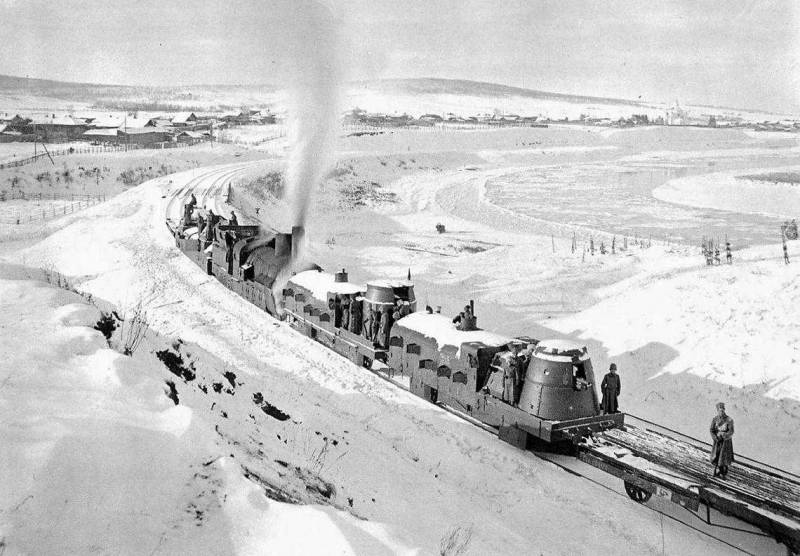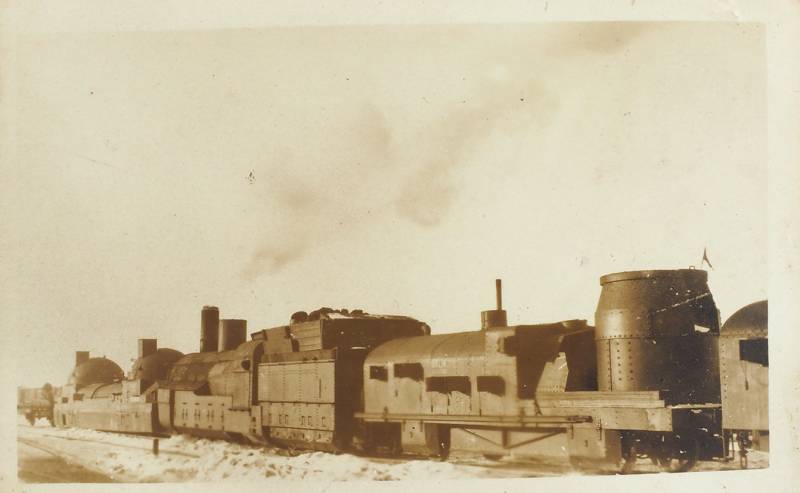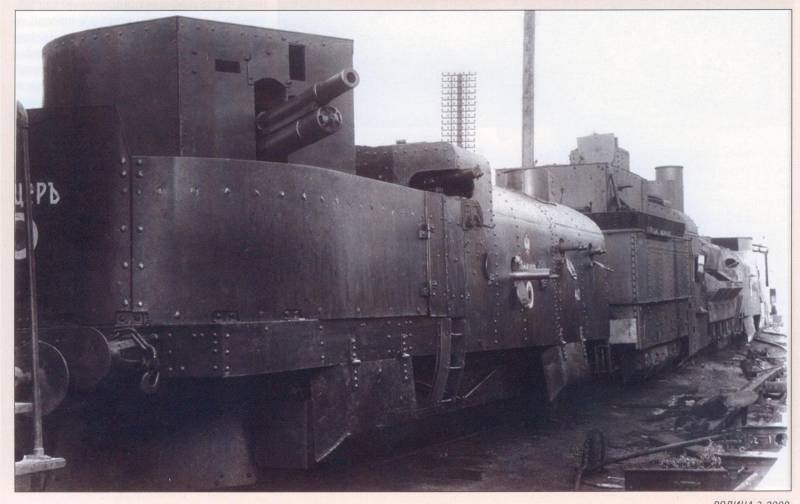Their finest hour. Armored trains in the Russian Civil War
Theater of military operations
In the First World, third-degree armored trains were determined by the positional nature of the war. In the second, on the contrary, maneuverable. The armored trains were tied to the railways and did not keep pace with the motorized units using the ordinary road network. Therefore, both there and there they generally remained “out of work” and only influenced tactical episodes.
Another thing is the Civil War in Russia - an armored train firmly entered the list of images associated with it, along with a carriage or budenovka. Why did this happen?
The point, of course, is in the very character of the Civil. In large wars, regular armies clash between developed conventional opponents. Despite their size, they are more or less manageable and have a constant supply. To break through the front they occupy and put them to flight, serious forces must be engaged. Even some Romanian or Italian units near Stalingrad require the concentration of thousands of artillery pieces against themselves, hundreds of trains with ammunition, and many tanks and manpower.
The civil war was the result of the chaos that swallowed Russia. The army, mortally tired of a big war, self-destructed. In state structures it was a mess. Even considered the standard of party discipline and masters of centralized order-setting, the Bolsheviks in the first year of the war did not actually have a unified army. They tried to control many separate units, each of which had its own opinion - and often not only about tactics and strategy, but also about politics. For others, as a rule, everything was even worse.
Trump in the sleeve
In such circumstances, the fate of entire regions, and sometimes the entire country, was resolved by relatively small but persistent and relatively disciplined troops. In whites, for example, this backbone was the active part of the pre-revolutionary officers. At the very beginning, the Reds relied on the workers — the Red Guard detachments formed from them were one of the most reliable groups that Moscow could count on.
But most of the workers, by virtue of their profession, did not participate in the First World War. On the one hand, it was good - they did not have time to get tired of the war. On the other - the Red Guards did not have combat experience. But they got along well with the mechanisms. In the logic of this friendship with technology, there was a solution - to strengthen human flesh with steel of armored trains. Fortunately, red lucky enough to capture most of the industrial centers and (at first) almost the entire railway network of the country.
In the conditions of general chaos, an armored train was an extremely convenient weapon. Mobile, armored, well-armed, he could quickly be transferred from one region to another. And upon arrival, it became a serious weight on the scale - the Civil War is not the First World War, the saturation with artillery is tens and hundreds of times less. A stable solid front in the Civil War was absent, which opened the way for dashing raids on the "hit-and-run" principle. From a vulnerable big game, an armored train turned into a chthonic horror on a railway track.
Of course, to use such a weapon did not disdain no one - if only it fell into the paws, and the task will be found. This led to the appearance of the most unusual "railway" destinies.
Armored train that saw the world
One of the most remarkable compositions in this respect was the famous "Orlik". The overthrow of the Provisional Government this armored train of the “Hunghus” type was met in Kiev, where the UNR government laid hands on it. The composition was solemnly renamed into the predictable for such a situation “Glory to Ukraine”.
But that was only the beginning. In January, the Red take Kiev 1918. They launder the "Glory to Ukraine" and rename the armored train to "Polupanovtsy", by the name of the new trophy commander, Andrey Polupanov. The train is doing quite well at war, on the way it is renamed again to the resounding “Freedom or Death”, and travels east to crush the rebel Czechoslovakians.
There things are no longer so good. Parts of the Czechoslovak Legion capture “Freedom or Death” not far from Simbirsk, and rename it “Orlik” - in the future it will be associated with this name.
Legionnaires use the train as a mobile reserve for the protection of the Trans-Siberian Railway - “Orlik” rolls back and forth and acts against the red partisans and ordinary gangs. But in the autumn of 1920, the legion nevertheless realized its long-standing dream and left the rushing Russia, like the Greeks of Xenophon, through the port of Vladivostok located in the opposite direction from their native places.
The armored train went to seaside white. Their end is known - having suffered defeat, they rushed out of the country. They did not give “Orlik” to the hated Bolsheviks - the squad was overtaken to Manchuria. There his tracks are lost. Perhaps, he was “ripped off” right up to hotel cars. But, if Orlik remained one, he could well fall into the Japanese hands that occupied the region in 1931. Who knows - perhaps the Red Army nevertheless reached the armored train after decades, destroying it with a tank attack or air strike in August 1945.
The example of "Orlik" was far from the only one - the conditions of the Civil allowed such things to happen many times.
Take, for example, the composition of General Annenkov, which also remembers the shots of the First World War. October 1917-th - captured by the sailors and went to the civil war in Finland. There hit the enemy. And then individual armored cars fought with the Soviet Union in the Winter War and the Second World War.
Psychic attack
Actively acting in the reality of the Civil War, armored trains inevitably absorbed it into themselves. Take, for example, mental attacks. The brain immediately draws a picture from the movie "Chapaev" - the White Guards adamantly march on a machine gun ready for battle.
This, of course, was not, but the first year of the war gave rise to a strange, at first glance, tactical paradigm. When the whites almost did not have cartridges, and the red reliable, welded troops. Therefore, private attacks, designed to open fire only at the very last moment, could lead to success. A weak opponent ran away before a very mean fire was opened.
Such cases were not only in the infantry battle. 1 June 1919 of the year saw the psychic attack on the railway go. Her main character was the white armored train "Officer", faced right away with two of her fellow warriors on the side of the Reds. The ammunition is over. It would seem that it's time to step back, but a good shot of the enemy broke the way.
Variants of the “Officer” team were, at first glance, few in number - inevitably turn into a pile of smoking debris or scatter and leave the composition to the enemy. The commander chose the third option - the train resolutely moved towards the Reds. Those showed caution - if white behaves so arrogantly, it means that he has some sort of trump card up his sleeve. And hurried away. What gave the “Officer” team the opportunity to quickly complete the repair of the tracks and retreat in good time.
Highest point
Participants in the Civil War became more than 300 armored trains. Two decades later, the Great Patriotic War was not "more modest" in quantitative terms - on the Soviet side alone the 224 armored train was used. But the specific influence on the course of the fighting has sharply decreased - armored trains dissolved in tens of millions of people, tank wedges and mass bombardments.
No, armored railway monsters are not dead. They still had to participate in a number of armed conflicts. But with the end of the Civil War in Russia, their true high point was completed.



Information